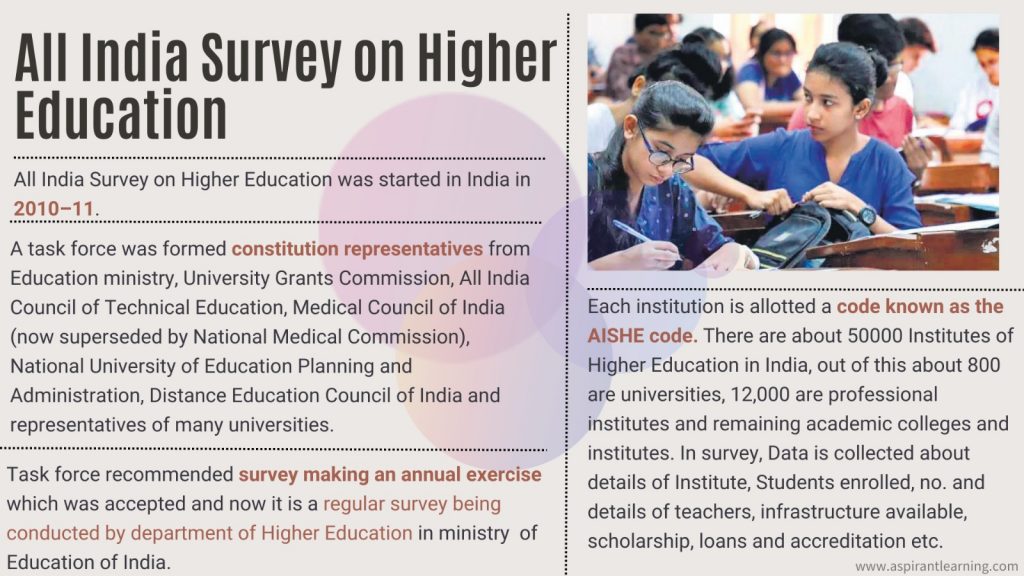News Highlights:
- Higher Education data: Recently, The Union Ministry of Education released data from the All India Survey on Higher Education (AISHE), 2020-2021, which showed a 7.5% increase in student enrolments across the country compared to 2019-20, with total student enrolments reaching 4.13 crore.
- The survey also revealed that in 2020-21, when the COVID-19 pandemic began, there was a 7% rise in enrolments in distance education programmes.

All India Survey on Higher Education Data:
- Students enrollment:
- The data showed that there were 2 lakh more SC students who got enrolled in 2020-21 compared to the previous year.
- About 3 lakh more ST students and 6 lakh more OBC students enrolled on Higher Education.
- There is a notable increase in OBC student enrolment since 2014-15 of around 36 Lakh (32%); however, the proportion of SC students dropped to 14.2% in 2020-21 from 14.7% the previous year, and the proportion of OBC students dropped to 35.8% in 2020-21 from 37% the previous year.
- The proportion of Muslim students enrolling for higher education dropped from 5.5% in 2019-20 to 4.6% in 2020-21, with the proportion of ‘other minority students’ dropping from 2.3% to 2% in the same period.
- The number of students in the Persons with Disabilities category also dropped in 2020-21 to 79,035 from 92,831 the previous year.
- Female enrolment in higher education programmes had increased to 49% of total enrolments in 2020-21 compared to 45% the previous year, and the Gross Enrolment Ratio for all enrolments (as per the 2011 Census) increased by over 2 points to 27.3.
- Most popular courses:
- Among all undergraduate enrolments, the most popular remained the Bachelor of Arts programme, which saw 104 lakh enrolments (52.7% women; 47.3% men), followed by Bachelor of Science courses, where women outnumbered men.
- This was followed by the Bachelor of Commerce programme, where women accounted for 48.5% of enrolments.
- In B.Tech and Bachelor of Engineering courses, women accounted for less than 30% of all enrolments.
- At the postgraduate level, the most popular courses remained in the Social Sciences stream. Women accounted for 56% of enrolments in 2020-21, followed by Science courses, where women accounted for 61.3% of all enrolments. Except for management courses at the PG level, where enrolment of women stood at 43.1%, all other PG courses saw women outnumbering men.
- At the PhD level, the most popular course was in Engineering and Technology, followed by Science; in both disciplines, women accounted for less than 50% of enrolments (33.3% for Engineering and Tech; and 48.8% for Science).
- The overall figures for STEM enrolments (at all higher education levels) showed that women lagged behind men, who accounted for over 56% of these fields.
- Number of Universities:
- During 2020-21, the number of Universities has increased by 70, and the number of Colleges has increased by 1,453.
- A total of 1,113 universities, 43,796 colleges and 11,296 standalone institutions were registered in AISHE 2020-21. 1,099 universities, 41,600 colleges and 10,308 standalone Institutions have filled and verified their responses.
Significance of Higher Education:
- Self-reliant India:
- Self-reliant India needs a continuous supply of trained, skilled human resources, which is possible only if a strong higher education ecosystem is developed in India to harness the potential of demographic dividend.
- Societal Issues solutions:
- Research in India has focussed on the theoretical paradigm.
- However, it is time the research is moulded towards nationally important and globally significant subjects to contribute to nation-building.
- Plurality and Diversity:
- To develop the horizons of the mind, it is important to provide a diversified, plural environment in which the students can understand others’ viewpoints and shape their perceptions accordingly.
- Empowerment of Women:
- To achieve its full potential and to guide the world towards sustainable development through the dissemination of spiritual knowledge, it is imperative to focus on the inclusion of the better half in higher education by rejecting the notion of gender bias in its entirety.
- The inclusion of women also projects better accessibility of education for vulnerable groups to escape the vicious cycle of poverty and malnutrition.
Pic Courtesy: Freepik
Content Source: The Hindu



